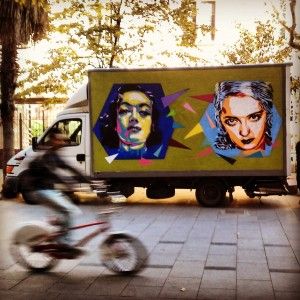For some years now, I have been looking for and photographing street art wherever I go… for so long now that I think I’ve developed a special third eye, which is highly selective and able to hone in on stencils, graffiti, etc. in a way that is, I dare say, nearly surgical.
It all began with an aficionado’s interest in art. What people said sullied cities and was vandalism, to an aficionado of art and beauty (possibly two highly subjective concepts) looked like little pieces of happiness that unexpectedly popped up around the city.
It didn’t take long for the view of the ethnographer and analyst of trends to appear, delving deeper and trying to understand a phenomenon that is both highly local and can be found around the world, and I soon realized that street art is also a manifestation of the macrotrends that are having a huge impact on us and, of course, reproduces group behaviors, both among the artists themselves and among aficionados and followers of this constantly evolving movement.
Street art is a totally urban phenomenon. We can’t forget that half of the world population lives in cities and experts estimate that by the middle of this century this could rise to 75%. It’s no surprise, then, that all sectors of activity are affected by this high concentration of the population in cities, nor that it has impacted areas like urban planning, art and culture, and the digital arena.
Obviously, the use of urban space is being reconsidered on all levels, not just institutionally, but also by residents themselves and specific groups like artists. Street art, which began about four decades ago in New York –I recommend the book “Getting Up: Subway Graffiti in New York[1]”- with young graffiti artists, rethinks urban space and its use. By looking and hunting for graffiti, we discover the urban space around us and, of course, how it is used. And this leads us to another recommendation for those interested: “The Contested Gallery: street art, ethnography and the search for urban understandings”. [2]
Artists and aficionados, as the social group we are, also take advantage of social media to show off what they do (the former) and find (the latter) and, as users, we become subjects of one of the most human phenomena that is taking the digital arena by storm: gamification.
Basically, we play, compete to see who is the first to find a piece and share and help each other to find more, with extensive use of smartphones and specific social networks.
I have two personal examples: the first, a Barcelona-based artist, via Instagram, challenged me to look for, find and share a series of pieces he had left around Barcelona. Obviously, I accepted the challenge… and we did it together on Instagram.
Picture taken by me in Barcelona. By BTOY Andrea
The second example is the fever that took over Barcelona when a well-known French artist visited the city just a few days ago, with all of us taking to the streets like crazy people to take and share pictures of his work.
And let’s not forget the madness that broke out when an extremely well-known artist recently visited NYC and that places like Brussels already have special tours of urban art in the city, as a way to show different aspects of its urban life.
I have to say that it fascinates me how social groups are adopting and adapting technologies and macro trends into their daily life.
I could name many artist and examples of the use and following of street art, but I invite you to discover it for yourselves: it’s much more fun.
